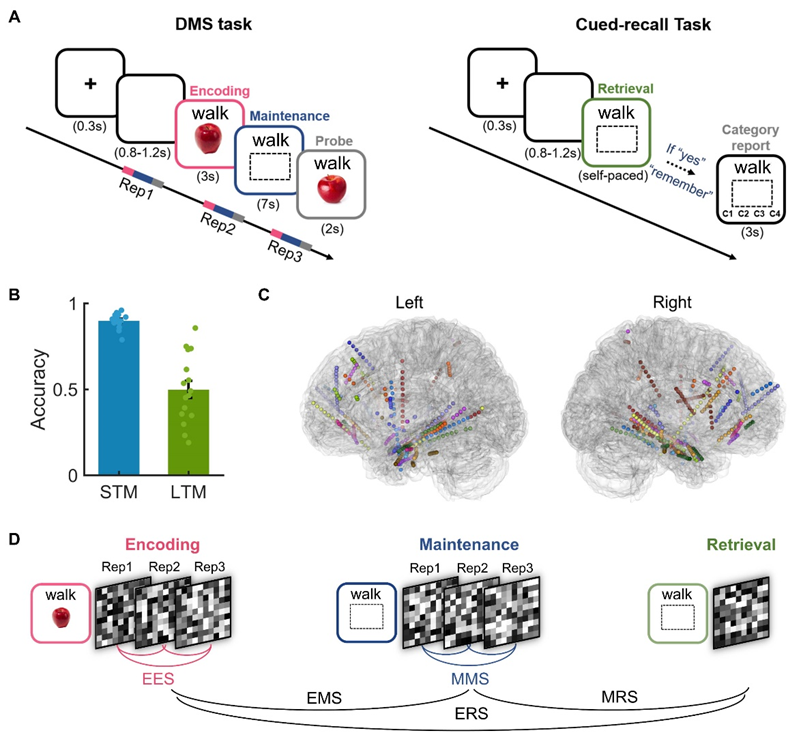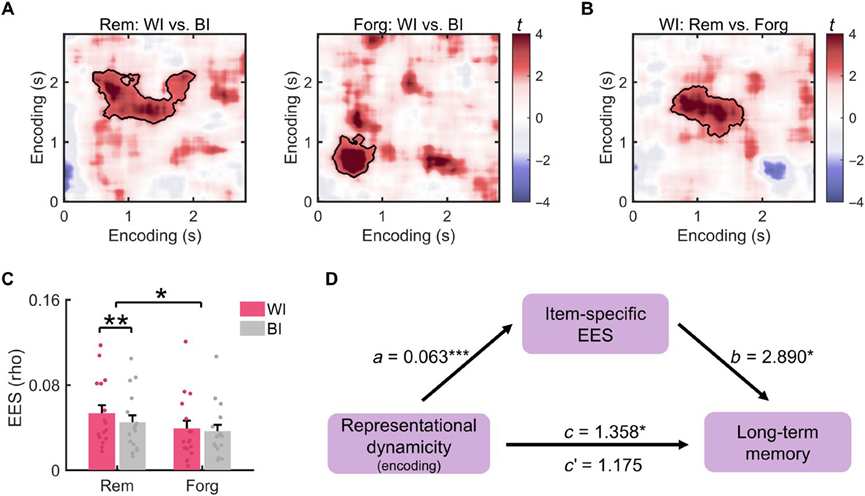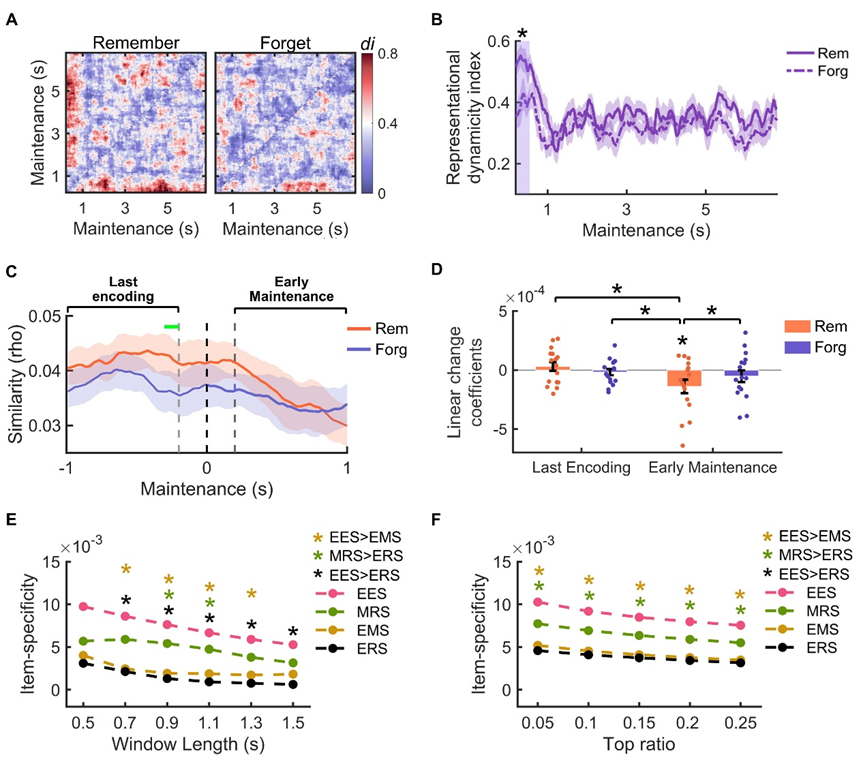On October 8th, 2021, Professor Gui Xue and his research team at the State Key Laboratory of Cognitive Neuroscience and Learning, Beijing Normal University, have online published their work entitled “Transformative neural representations support long-term episodic memory” in the high-impact peer-reviewed journal, Science Advances. This study has found that neural representations of memory dynamically change from initial encoding to short-term memory maintenance and then long-term memory retrieval. Specifically, this study has shown (1) dynamic encoding supports the long-term memory formation via enhancing the representational fidelity during the late encoding period; (2) Representational transformation continues from the immediately post-encoding period up to the memory retrieval.
As early as the 1930s, Bartlett noted that “Remembering is not the re-excitation of innumerable fixed, lifeless and fragmentary traces, but rather an imaginative reconstruction or construction”. However, largely influenced by Tulving’s idea, which regards episodic memory as mental time traveling, in the past decade, a large number of studies were dedicated to examining the similarity of neural activity patterns between memory encoding and retrieval, while ignoring the differences between them. Using intracranial EEG recordings and a novel experimental paradigm that combines a delayed-match-to-sample task and a long-term memory cued-recall task, the current study gained deep insight into the content and changing patterns of neural representations across different memory stages.

Figure1.Experimental paradigm, electrodes localization, and data analysis scheme
The study showed that neural representations of learning items experienced rapid transformation, changing from visual formats to abstract semantic formats. Subsequent remembered items in the long-term memory test showed greater representational transformation as compared with subsequent forgotten items. This transformation could result in more stable item-specific representations during the late encoding period, thus further contributing to long-term memory formation. In line with previous work (Xue et al., 2010; Lu et al., 2015); Feng et al., 2019), these results suggest that the interaction of external inputs and internal stored long-term knowledge helps us to form stable representations of memory and long-term memory formation.

Figure 2. Representational fidelity during encoding improves long-term memory and mediates the beneficial effect of encoding dynamicity.
This study also found that during the post-encoding maintenance period, the neural representation of memory further undergoes rapid and continuous changes. First, within 0-350ms post-encoding, remembered items showed greater representational changes as compared with forgotten items; Second, the neural patterns during successful long-term memory retrieval are more similar to that during the short-term memory period than the encoding period, indicating that successful memory retrieval reinstates the neural representation of the items in the short-term memory rather than the neural representation during perception.
Systematic comparisons further revealed that the item-specific representational similarity between multiple repetitions within the same memory stage is significantly greater than the similarity between different stages, indicating that the neural representation of memory has experienced the multi-stage transformation from encoding to long-term memory retrieval.

Figure 3. Multistage transformation of representations from encoding to maintenance and retrieval.
Professor Xue Gui and his team have been dedicated to revealing the neural mechanism of memory (Xue, 2018). Based on the neural activation pattern reinstatement theory (Xue et al., 2010; Lu et al., 2015; Feng et al., 2019), the team has consistently discovered the dynamic change of neural representations during memory in recent years. In 2017, the team, for the first time, reported that from encoding to long-term memory retrieval, the core brain area of memory representation was transferred from the visual cortex to the parietal cortex (Xiao et al., 2017); subsequently, employing intracranial EEG recordings, the team found that short-term memory maintains high-level visual and abstract semantic representations instead of primary visual representations. Moreover, these representations are coupled with the phase of hippocampal low-frequency oscillations to maintain the stability of short-term memory (Liu et al., 2020). In August 2021, using the Memory of Loci task, the team found that the hippocampus reduces the interference between adjacent items via flexible conversion of memory representations, which supports the formation of fast and efficient memories (Liu et al., 2021). In addition, they found that the dynamic transformation of representations may also lead to the formation of false memories (Zhu et al., 2019)).
This research was accomplished by Professor Gui Xue and his team, together with their collaborators, Professor Nikolai Axmacher from Ruhr University Bochum, Germany, and Professor Tao Yu, Professor Liankun Ren, and Professor Duanyu Ni from Xuanwu Hospital of Capital Medical University. The paper’s first author is Dr.Jing Liu, who has graduated from the State Key Laboratory of Cognitive Neuroscience and Learning, and Professor Gui Xue is the corresponding author of the paper. This research was funded by the National Natural Science Foundation of China (31730038), China-Israel International Cooperation Research Fund (31861143040).
The link to the paper:https://www.science.org/doi/10.1126/sciadv.abg9715
References:
Feng, K., Zhao, X., Liu, J., Cai, Y., Ye, Z., Chen, C., & Xue, G. (2019). Spaced Learning Enhances Episodic Memory by Increasing Neural Pattern Similarity Across Repetitions. The Journal of Neuroscience, 39(27), 5351–5360. https://doi.org/10.1523/JNEUROSCI.2741-18.2019
Liu, C., Ye, Z., Chen, C., Axmacher, N., & Xue, G. (2021). Hippocampal Representations of Event Structure and Temporal Context during Episodic Temporal Order Memory. Cerebral Cortex, bhab304. https://doi.org/10.1093/cercor/bhab304
Liu, J., Zhang, H., Yu, T., Ni, D., Ren, L., Yang, Q., Lu, B., Wang, D., Heinen, R., Axmacher, N., & Xue, G. (2020). Stable maintenance of multiple representational formats in human visual short-term memory. Proceedings of the National Academy of Sciences, 117(51), 32329–32339. https://doi.org/10.1073/pnas.2006752117
Lu, Y., Wang, C., Chen, C., & Xue, G. (2015). Spatiotemporal Neural Pattern Similarity Supports Episodic Memory. Current Biology, 25(6), 780–785. https://doi.org/10.1016/j.cub.2015.01.055
Xiao, X., Dong, Q., Gao, J., Men, W., Poldrack, R. A., & Xue, G. (2017). Transformed Neural Pattern Reinstatement during Episodic Memory Retrieval. The Journal of Neuroscience, 37(11), 2986–2998. https://doi.org/10.1523/JNEUROSCI.2324-16.2017
Xue, G. (2018). The Neural Representations Underlying Human Episodic Memory. Trends in Cognitive Sciences, 22(6), 544–561. https://doi.org/10.1016/j.tics.2018.03.004
Xue, G., Dong, Q., Chen, C., Lu, Z., Mumford, J. A., & Poldrack, R. A. (2010). Greater Neural Pattern Similarity Across Repetitions Is Associated with Better Memory. Science, 330(6000), 97–101. https://doi.org/10.1126/science.1193125
Zhu, B., Chen, C., Shao, X., Liu, W., Ye, Z., Zhuang, L., Zheng, L., Loftus, E. F., & Xue, G. (2019). Multiple interactive memory representations underlie the induction of false memory. Proceedings of the National Academy of Sciences, 116(9), 3466–3475.
https://doi.org/10.1073/pnas.1817925116